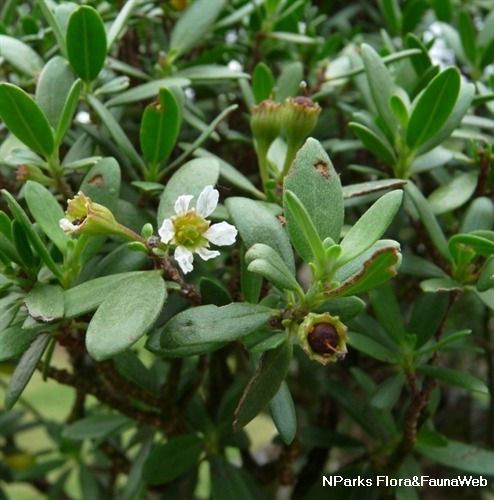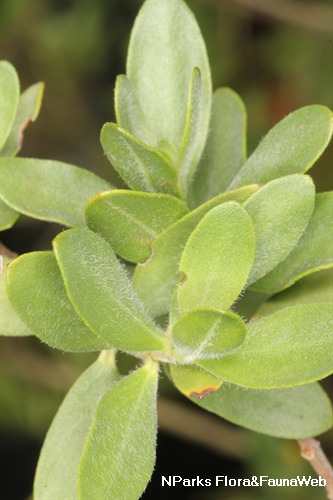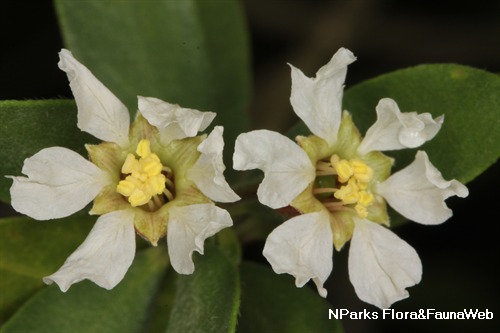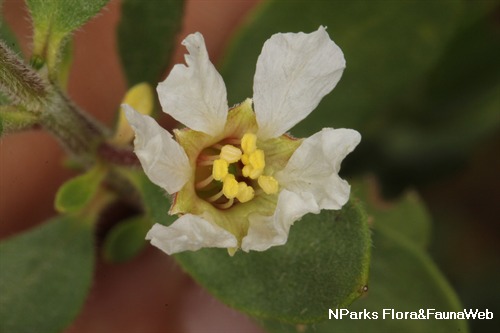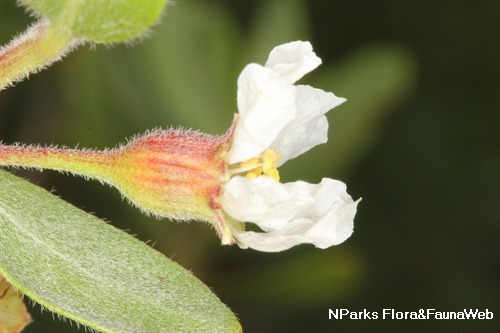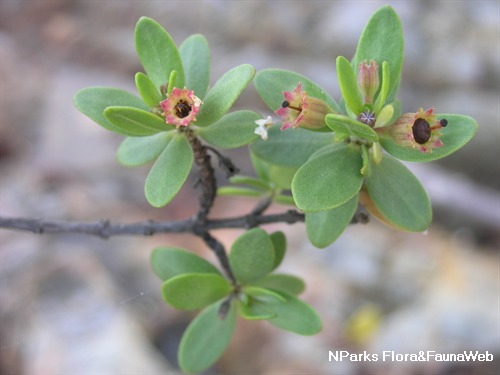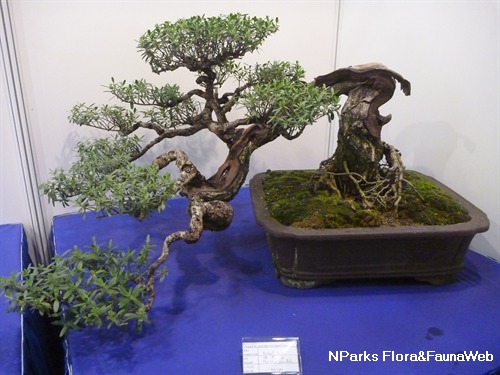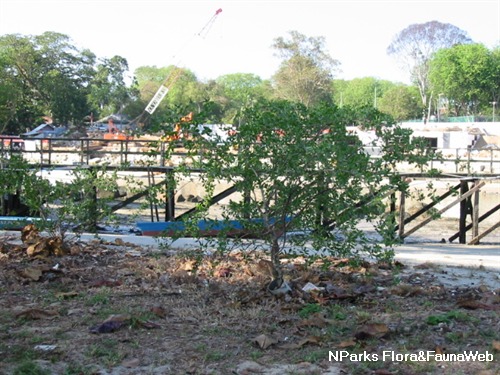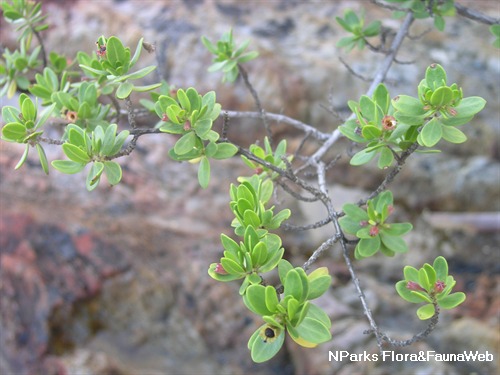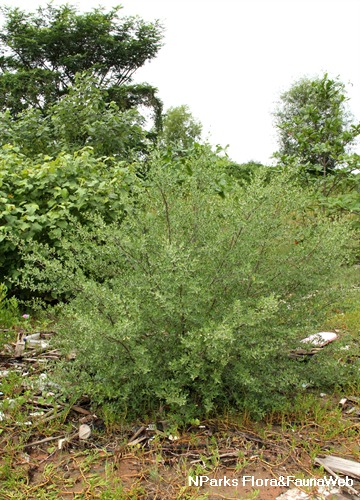
Back
Pemphis acidula J.R.Forst. & G.Forst.
| Family Name: | Lythraceae |
| Synonyms: | Melanium fruticosum, Lythrum pemphis |
| Common Name: | Pemphis, Shrubby Coral Pemphis, Small-leaved Mangrove, Mentigi, Mentigi Laut, Kabantigi, 水芫花 |
Name
Classifications and Characteristics
| Plant Division | Angiosperms (Flowering Seed Plants) (Dicotyledon) |
|---|---|
| Plant Growth Form | Shrub, Tree (Small (6m-15m), Shrubby (1m-5m)) |
| Lifespan (in Singapore) | Perennial |
| Mode of Nutrition | Autotrophic |
| Plant Shape | Shrubby, Irregular |
| Maximum Height | 4 m to 11 m |
| Tree or Palm – Trunk Diameter | 1 |
Biogeography
| Native Distribution | East Africa, Indian Ocean islands, Southern China, Taiwan, Philippines, Malesia, Northern Australia, Pacific Ocean islands. |
|---|---|
| Native Habitat | Terrestrial (Coastal Forest), Shoreline (Mangrove Forest, Sandy Beach, Rocky Beach) |
| Preferred Climate Zone | Tropical, Sub-Tropical / Monsoonal |
| Local Conservation Status | Native to Singapore (Critically Endangered (CR)) |
Description and Ethnobotany
| Growth Form | It is a shrub or tree up to 10 m tall, often forming dense thickets along rocky or sandy coasts and fringes of mangroves, and are semi-submerged during high tide. |
|---|---|
| Foliage | Its opposite, shortly-stalked, silvery-green leaves have velvety, fleshy leaf blades that are elliptic-oblong, and 1–3 by 0.3–1 cm. |
| Flowers | Its white or pale-pinked petalled flowers are 1-1.5 cm wide, developing singly or 2–3 in the angles of the leaves. |
| Fruit | Its obovoid fruits are capsules that turn reddish-green to brown when ripe, splitting to release the seeds. |
| Others - Plant Morphology | Popular amongst bonsai enthusiasts for its rugged, gnarled twisted trunk. Species endangered in Sinagpore due to habitat loss. Last wild plant remaining on mainland Singapore is a 4m-tall tree at Changi Point Beach Park. However, it toppled over in a storm in 2006. |
| Habitat | It grows on rocky or sandy coasts and fringes of mangroves, often submerged during high tide. |
| Associated Fauna | Its flowers are pollinated by insects such as bees. |
| Cultivation | It can be propagated by seeds or stem cuttings. |
| Etymology | Greek Pemphis, swelling, referring to the swollen mature fruits; Latin acidula, sour, which may refer to the taste of the leaves. |
| Ethnobotanical Uses | Edible Plant Parts : Edible Fruits, Edible Leaves Food (Herb or Spice): Bark and wood mixed with toddy palm and used as baby food in some Pacific Islands. (Fruit or Vegetable): The acidic leaves are edible. Fruits eaten or used as animal feed. Medicinal: Bark and flowers used medicinally in Micronesia and Tahiti. Timber & Products: Extremely hard wood used for house construction, carved implements like tool handles, fish hooks and pounders. Others: Scrapped bark yields red dye. |
Landscaping Features
| Landscaping | Its small leaves look silvery, and the plant is used in bonsai. It is suitable for gardens, or parks as a border or hedge. |
|---|---|
| Desirable Plant Features | Ornamental Flowers, Ornamental Foliage, Ornamental Form |
| Landscape Uses | Coastal Plant, Suitable for Bonsai, Container Planting, Parks & Gardens, Small Gardens, Beachfront / Shoreline |
| Thematic Landscaping | Rockery / Desert Garden, Naturalistic Garden, Silver Garden |
Fauna, Pollination and Dispersal
| Pollination Method(s) | Biotic (Fauna) (Insects (Bee)) |
|---|---|
| Seed or Spore Dispersal | Abiotic (Water, Explosive Dehiscence) |
Plant Care and Propagation
| Light Preference | Full Sun |
|---|---|
| Water Preference | Moderate Water, Little Water |
| Plant Growth Rate | Moderate |
| Rootzone Tolerance | Well-Drained Soils, Saline Soils / Salt Spray, Drought Tolerant |
| Pruning | Prune and re-wire plant every few months if grown as bonsai. |
| Fertilizing | Fertilize regularly to attain maximum growth potential. |
| Diseases | Leaves prone to being attacked by caterpillars. Roots may be prone to nematode infestation, esp. if media used is completely inorganic. Mix crushed shrimp or crab shells into media to treat problem. |
| Propagation Method | Seed, Stem Cutting, Tissue Culture |
| Propagule Establishment Remarks | Cuttings may be planted bare-rooted. Plant sends out new roots quickly when potted in moist growing media. |
| Maintenance Requirements Remarks | If pruned and wired for bonsai purposes, retain some leaves at branch tips, or else branch may die back. For good health, plant prefers to be sprayed with seawater regularly. |
Foliar
| Foliage Retention | Evergreen |
|---|---|
| Mature Foliage Colour(s) | Green, Silver / Grey |
| Mature Foliage Texture(s) | Leathery, Thick, Velvety / Furry / Tomentose |
| Foliar Type | Simple / Unifoliate |
| Foliar Arrangement Along Stem | Opposite |
| Foliar Attachment to Stem | Petiolate |
| Foliar Shape(s) | Non-Palm Foliage (Lanceolate, Elliptical, Oblong) |
| Foliar Venation | Pinnate / Net |
| Foliar Margin | Entire |
| Foliar Apex - Tip | Acute |
| Foliar Base | Cuneate |
| Typical Foliar Area | Nanophyll ( 0.25cm2 - 2.25 cm2 ), Microphyll ( 2.25cm2 - 20.25 cm2 ) |
| Leaf Area Index (LAI) for Green Plot Ratio | 4.5 (Shrub & Groundcover - Dicot) |
Non - Foliar and Storage
| Trunk Type (Non Palm) | Woody |
|---|---|
| Stem Type & Modification | Woody |
| Root Type | Underground (Tap Root, Fibrous Root) |
Floral (Angiosperm)
| Flower & Plant Sexuality | Bisexual Flowers |
| Flower Colour(s) | White |
|---|---|
| Flower Grouping | Solitary, Cluster / Inflorescence |
| Flower Location | Axillary |
| Flower Symmetry | Radial |
| Ovary Position | Superior / Hypogynous |
| Flowering Habit | Polycarpic |
Fruit, Seed and Spore
| Mature Fruit Colour(s) | Brown |
|---|---|
| Fruit Classification | Simple Fruit |
| Fruit Type | Dehiscent Dry Fruit , Capsule |
Image Repository
Others
| Master ID | 1018 |
|---|---|
| Species ID | 2312 |
| Flora Disclaimer | The information in this website has been compiled from reliable sources, such as reference works on medicinal plants. It is not a substitute for medical advice or treatment and NParks does not purport to provide any medical advice. Readers should always consult his/her physician before using or consuming a plant for medicinal purposes. |

